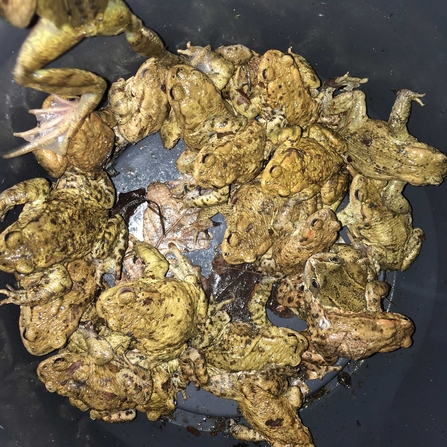It’s the evening of February 20th 2025. After months of waiting and weeks of carefully checking the weather forecasts I am confident that tonight will be the night – the beginning of an amazing annual wildlife occurrence. I put on my waterproofs, grab my bucket and net as well as my torch, and head out. My destination is our local migratory toad crossing to join my fellow toad patrollers for our first patrol of the year.
Whilst we tend to associate toads with water, they actually spend most of the year living on land, foraging for food in woods and gardens. However when it is time for the breeding season they all migrate back to the pond or lake that they were spawned in. During the first mild and wet nights in February thousands of toads all leave the places that they have been spending the last nine months, and start converging on their ancestral ponds from all directions. This mass toad migration happens every year at hundreds of places all over the UK.
But there is a problem. Although toads have kept the same routine and migrated back to the same place for decades or even much longer in some places, the landscapes around their breeding ponds have changed. Roads have been constructed across the migratory routes, bringing dangers with them. Every year an estimated 20 tonnes of toads are killed on roads as vehicles run over the migrating amphibians.
For the toads who manage to avoid being squashed and make it to the other side of the road, they are faced with another danger - drains! The toads reach the far side of the road and are met with a high kerb. They walk on the road alongside the kerb, looking for a gap in the kerb so that they can get off the road and continue their journey. However before they find a gap, they end up falling down a road drain, landing around four feet down in water. Whilst toads are good swimmers, if left to swim around in the drains they will eventually get exhausted and drown.
The perils of this journey often result in toad populations in areas declining, as only a fraction of the toads manage to successfully make it to the water, breed, and then make it back across the roads. The toads need help to safely make it across the road.
This is where toad patrols come in. Toad patrols are organised groups of volunteer patrollers who go out on mild and rainy evening in February, March and April and help the toads to reach their breeding ponds safely. This can involve scooping up toads from the roads before they get squashed by vehicles or using a net to rescue toads which have fallen down drains, collecting them in a bucket, and releasing them safely clear of the road on the pond side. In places where the roads are very busy, some patrols even set up barriers to stop the toads from reaching the road, then the patrollers collect the toads from along the barriers and carry them across the road to release them on the other side.
So back to February 20th. I am the current patrol manager of the Cobham toad patrol where people have been helping the toads reach their breeding lake since 1987. I have been keeping a close eye on the weather forecast and have determined that the 20th is the day that we are likely to start seeing toad movement. The day before I have visited the toad crossing area, and with the help of two other patrollers and a kind resident, we have opened up the migratory toad crossing road sign and installed special toad ladders in the drains nearest the lake which will help some of the toads to climb out by themselves.

